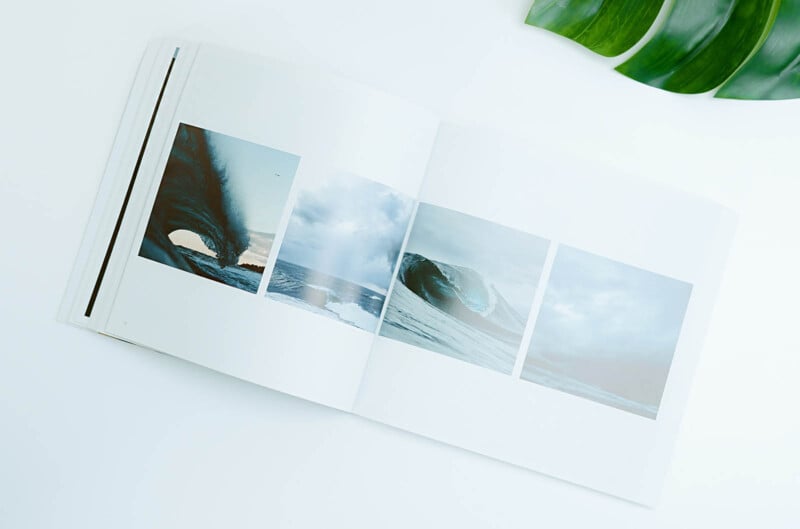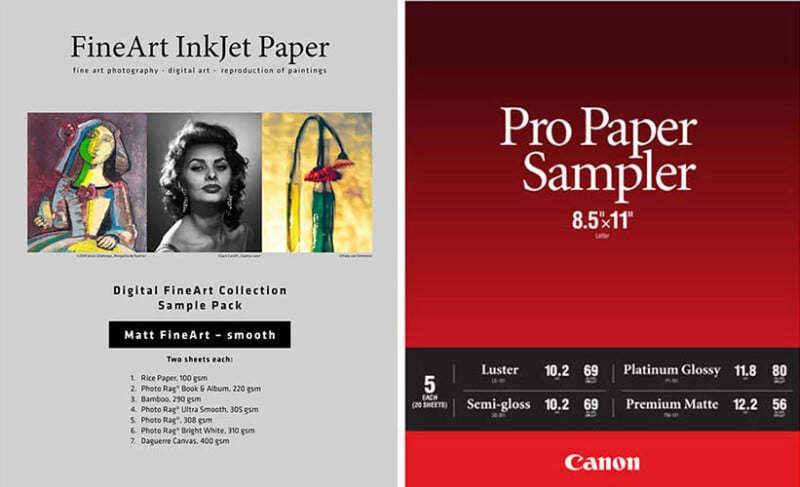Glossy vs. Matte Photo: Which is Best for Printed Pictures?
![]()
Printing your photography is a great way to display it, give it as a gift, and experiment with different ways to present your work. One aspect of printing that will inevitably come up is the type of paper that you want to print on — should you choose glossy or matte?
This article will cover the pros and cons of glossy and matte photo papers, one of the most impactful and common decisions you’ll have to make when choosing a paper.
What Are Glossy and Matte Papers?
You’ve probably seen both types of prints, and they are both fairly common. Glossy prints are shiny and smooth, as their name implies. Their shine comes from plastic-like compounds that are added to the paper’s coating. You’ll usually see glossy prints in large-quantity print applications, such as photo booths.

On the other hand, matte photo papers are more dull and lack shine. Most photos that are displayed in museums and galleries are printed on matte papers, although this doesn’t mean that matte papers are always the best choice.

Other terms that you may come across when reading about photo printing include metallic, luster (sometimes spelled “lustre”), satin, and pearl papers. This article won’t compare all of these in-depth, but they all essentially fall between glossy and matte in terms of how they present colors and reflect light.
Luster, satin, and pearl papers are also called “semi-gloss” papers because they fall between glossy and matte papers in terms of how much light they reflect. Metallic papers are less common, and they give images a slight shimmer. They also tend to be more shiny and expensive than luster papers.
Both glossy and matte printing options are readily available through print labs or art and office supply stores if you’re printing yourself. There are instances where you’d be better off using one over the other depending on where your image is going to be displayed, how it will be presented, and its characteristics.
Although it’s important to think carefully about printing using matte or glossy papers, if you happen to print using the “wrong” paper type for your situation, it’s not the end of the world. You will still see great colors and contrast, and your image won’t be ruined. Think of these pros and cons as suggestions for how you should consider glossy and matte papers in different scenarios.
The Pros and Cons of Glossy Photo Papers
Pro (in most cases): Glossy photo papers tend to enhance colors and contrast. If you have images where you’d like to emphasize their colors and contrast, glossy papers tend to create a slight “pop” in both aspects. This is because of the composition of glossy coatings, which have different light-reflective properties than matte coatings. This can work against some images, but it’s usually not a huge or very noticeable difference.
Pro: High light reflectivity. On one hand, if you don’t plan to frame your images, glossy prints can replicate the “glassy” look and draw attention to your prints. The shine that is added to prints on glossy paper catches the eye and adds another element to your images. This tends to work best if you don’t plan to display your images in direct light (see below).
Con: High light reflectivity. On the other hand, if you’re printing images that are going to be displayed in direct light sources, glossy papers will probably reflect too much light and distract from the images. You want viewers to be able to see the image’s colors and subject, and not have to work to get around light that is reflecting back into their faces.

Pro: More accessible in terms of cost and availability. Glossy prints require less ink to achieve similar color and contrast to matte photos, so they cost less to make. Glossy papers are usually the “default” at most large print suppliers, especially for smaller sizes such as 5×7” prints. If you ever visit a photobooth, chances are good that you’ll receive your images on glossy paper because it is more efficient to print on.
Con: Fingerprints and dust show. Glossy papers show fingerprints more easily than matte papers do because of their reflective coating. It’s possible to get fingerprints and dust off of glossy prints, but if you plan for your images to be handled often, it’s a good idea to consider printing on a matte paper.
The Pros and Cons of Matte Photo Paper
Pro: Matte prints tend to work well with frames. Since the glass from a frame will reflect a small amount of light, framing gives matte papers an extra pop. Glass can be cleaned more easily than the shiny surface of a glossy paper, and different types of glass can be more or less reflective of light. When you frame glossy prints, there is usually too much shine from both the glass and the glossy coating, so matte prints are best for displaying prints in frames.

Con: Low light reflectivity. Matte coatings have properties that enable them to scatter light rather than reflect it. They are essentially uneven surfaces (at the microscopic level), and light that hits a matte print will be scattered. This can make matte prints more difficult to see in dimly lit environments, where a glossy print might look a bit brighter or at least fit better in the environment.
Pro: Low light reflectivity. If you plan to display your images with a light source, such as in a gallery or on a mantle that has direct lighting, matte prints will look great. Glossy papers would probably reflect the direct light too much, whereas matte papers will scatter the light and you will be able to see the details of the prints well.
Con: Less contrast and saturation. The nature of matte prints and their coatings produces prints with less saturation and contrast than glossy prints do. If you have images where you’d like to emphasize their colors and contrast, it’s probably best to print using a glossy paper.

That’s not to say that matte prints don’t have great colors and contrast – they still show both aspects very well. Glossy prints can sometimes add too much of a “pop” to your colors and contrast, which is also where a matte print would be better. If you are printing in black and white and have no colors to emphasize, matte prints are probably the best choice.
Pro: Fingerprints, dust, and scratches are less obvious and frequent. Matte prints tend to be more durable than glossy prints because of their coatings. Matte coatings reflect less light, so imperfections such as fingerprints are less visible (although they can still show up under the right conditions). Matte prints are also more durable than glossy prints, and it takes more to scratch a matte print than a glossy print.
Con: Usually more expensive and less accessible. In contrast to glossy prints, matte prints take more ink to print and are therefore usually more expensive. Matte prints are also usually more available at photo-specific print labs, and you’re less likely to find matte options at a pharmacy that prints photos, for example. If they do have matte options, they are likely less varied than glossy options.
So Which is Better for Printed Photos?
Both glossy and matte photo papers have advantages and disadvantages, mostly depending on what your prints will be used for and how they will be displayed.
If you’re preparing prints for exhibition in frames, you should probably choose a matte paper because the glass in the frame will already reflect enough light. If you’re printing hundreds of images to give to family and friends, it’s probably best to choose glossy paper because of cost, availability, and because you don’t know how they will display the images.
If you are printing instructional images to pass around in a classroom, matte papers will accumulate fewer fingerprints and scratches, so they are likely the best choice.
If you plan on printing images yourself as a photographer, you should probably spend the time and money to find the papers that work best for you. Ultimately, printing is an extension of the art of photography, and your prints can add to your photographic style.
Many paper suppliers offer “sample packs” of their different papers that are usually 8.5”x11”. You can buy matte and glossy sample packs, with different weights, textures, and qualities within each category.

Although it’s easy to feel like there are too many options, you will quickly find the papers that you like and dislike after a few trials. Some will print colors differently, and others will feel too flimsy or too hard.
As mentioned before, if you happen to print a photo using the “wrong” type of paper for your end goal, it’s not the end of the world. Your image will still look great, and most people probably won’t even see much wrong with it.
However, the next time you print photos, try printing or ordering prints on both glossy and matte papers so that you can see the color, contrast, and display differences for yourself. That will help inform your future printing decisions, and you may find a style that works best for you and your photography.